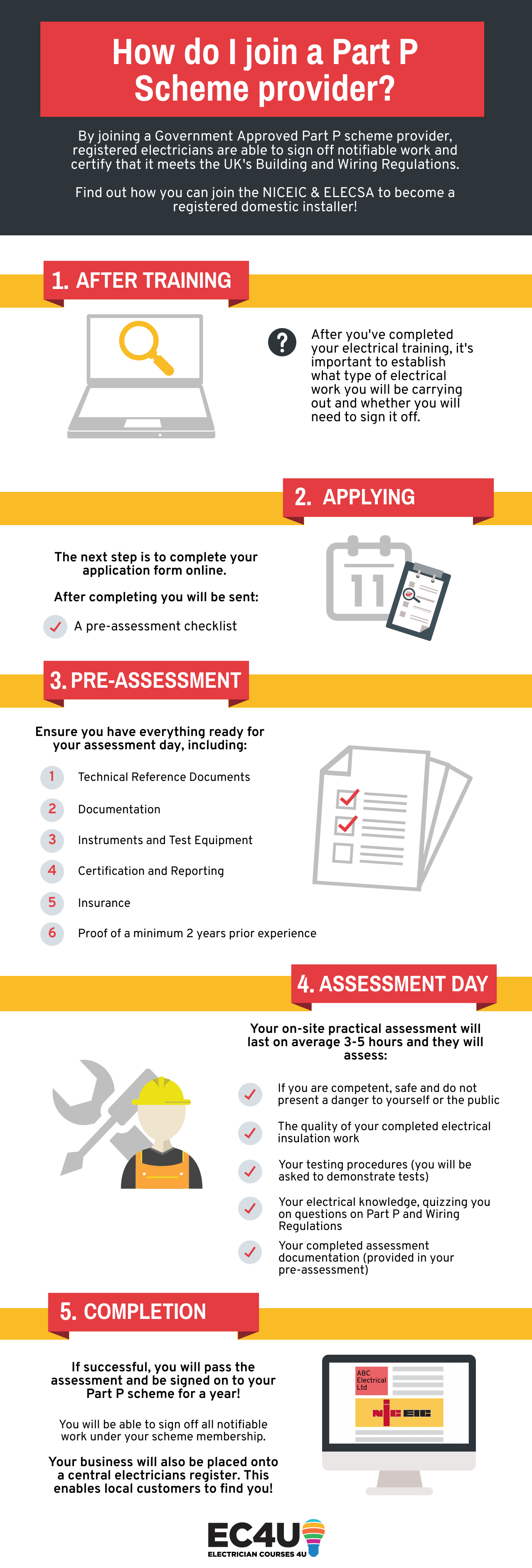How to join a Part P scheme provider and become an NICEIC domestic installer
Government Approved Part P scheme providers, such as the NICEIC, are designed to make sure electricians are working to the current Building & Wiring Regulations and safety standards for domestic dwellings.
By joining a Part P scheme provider, registered electricians are able to sign off notifiable work and certify that it meets set regulations.
The first thing is to establish what kind of electrical work you will be undertaking, to see if it is financially viable to join one of the Government approved Part P Scheme providers.
Since April 2013 Approved Document Part P has substantially changed, allowing electricians to do more work without the need to notify the work via Building Regulations. The only things that need notifying are:
- Installing a completely new circuit
- Replacing of a new circuit board/consumer unit
- House rewire
- Alteration or addition in special locations to an existing circuit (bathroom)
So it is important to look into what work you will be doing first, before you start looking at joining any of the Part P schemes.

How can I join a Part P competent persons scheme?
There are obviously benefits to joining one of the schemes, especially if you are doing notifiable work, as listed above.
Once you have completed your training and achieved your relevant qualifications you could be in a position to take a closer look at what the scheme providers are offering. First, it is important to remember that all competent persons schemes have joining criteria that you will have to meet, make sure that you have all the relevant qualifications and experience before applying to join.
Fees to join will vary with each provider and will be payable every year you wish to stay a member. If you renew your membership, you will have to undertake another practical assessment with the scheme provider.
Part P pre-assessment list
Each competent person scheme will have varying requirements, however, as a minimum you should have the following ready on your assessment day:
- Technical Reference Documents – The latest edition of the Wiring Regulations BS 7671, IEE On-Site Guide, Building Regulations Part P and Memorandum of Guidance on the Electricity at work regulations 1989.
- Documentation – Health and Safety policy, Risk Assessments, Quotation forms, and complaints log – The scheme provider will issue you example documents for all of these.
- Instruments and Test Equipment – The scheme provider will check that you have suitable equipment and it is calibrated.
- Certification and Reporting – You will be checked to ensure you have filled in your certification documents correctly for the installation jobs you are being assessed on.
- Insurance – A minimum of £2 Million Public Liability.
- Proof of experience – Each scheme will vary on their required experience level, it is important that you discuss this with your scheme provider to ensure that you have the relevant documents to hand, as proof.
Part P Assessment
On the day of your assessment, which typically can last from 3-5 hours, the inspector is looking to make sure you are competent, safe and do not present a danger to yourself or the public. They will be looking for the quality of your completed insulation work, ensuring you have taken into account cable sizing, volt drop, RCD Protection and reference methods.
The majority of the visit will be focusing on your testing procedures and you will be asked to demonstrate or talk through various tests. You will also have to show a completed schedule of test results for the circuits you are being assessed on.
There are no set tests you will be asked to perform as the inspector is looking for your full understanding of all dead and live tests. dead and live tests
Most probably you will also be asked some questions related to either the On-Site Guide or Part P of the Building Regulations, which again are designed to test your knowledge. If however you are not sure of the answer, it is perfectly alright to refer to your reference books to find the answer as that is what they are there for after all.
After your assessment
If you successfully navigate your way through the installation work, circuit testing, schedule of test results, you will have passed the assessment and are now part of a Part P Scheme and able to sign off all your own electrical work.
As well as being signed onto a scheme, you will also be placed on a central electricians register as registered, competent electrician. Customers can put in their post code and look up local registered electricians in their area, which gives you more opportunity for work.
Want to know more?
If you would like to know more about joining a Part P scheme provider, then please contact us or take a look at our Part P scheme provider FAQ’s.




